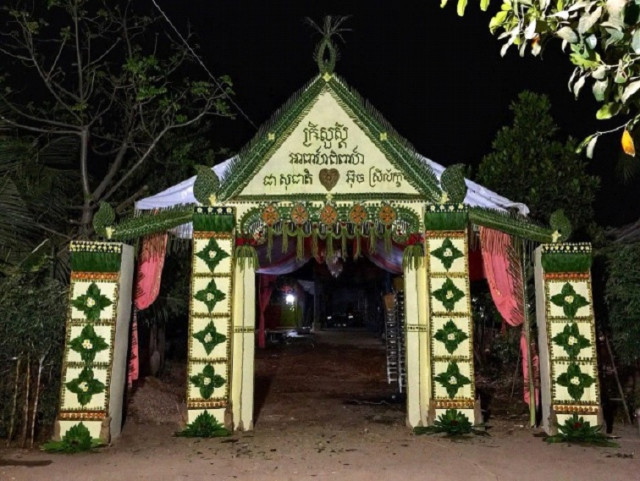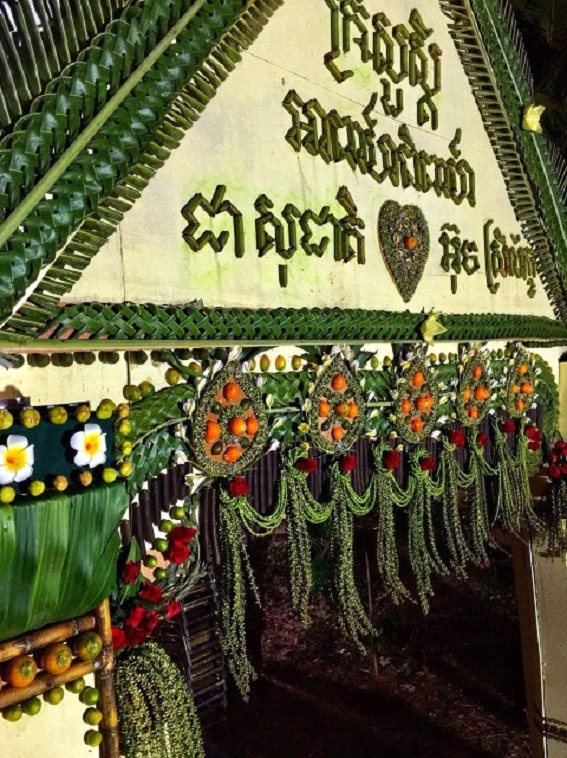Creatively Traditional: Organic Wedding Entrances

- Po Sakun
- March 23, 2020 2:32 AM
A Cambodian artist builds features for wedding halls using local flora
A combination of coconut stems, palm tree leaves, sugarcane, limes, aloe vera leaves, leoung reach fruit, reang phnom flower and champei flowers: All are skillfully intertwined as elements used by Sek Visal to build the main entrance of a venue for a Cambodian traditional wedding ceremony. With these unique handcrafted decorations, the entrance takes on the historical look of centuries-old temples with their beautiful artistry. All the natural components of the entrance and decorative features are found in Cambodia, and are affordable in terms of price. Visal believes in the idea of getting local materials both to help support local workers and protecting the environment.
An unplanned business
Visal, who was born in Svay Reang Province, said that, after his first attempt to use these natural elements to decorate a wedding entrance in Kandal Province, many people became fascinated by the decorations. “This is just the beginning,” he said. “If this one [I recently did] works out, then I am planning to do it on other occasions or for different applications.
“Many people made contact, asking me about prices, designs…Some customers have booked for two or three ceremonies in advance. Some just wanted to know the price,” Visal said, adding that most people who showed interest were from Phnom Penh.
As requests keep coming in for his wedding-ceremony entrances, Mr. Visal, the youngest of three children who was raised as a farm boy, considers this business only part-time work since he is an art teacher. The price range he has set depends on the size and elements of the designs. “This first entrance took me two nights and three days,” he said. To finish on time, he had to work past midnight several times. “On the last day, I stayed up till three in the morning,” he said. Due to the work involved and material required, the piece cost close to $2,000. “Prices vary according to design and components,” Visal said.
With his business still in its infancy, Visal has not yet been able to meet all demands and requirements, but he is working on this. “I have not made a sample book…with illustrations for customers,” he said. “I just do it by looking at designs. After agreeing on the price, I sketch a design for the clients.
“But I’m looking into to creating a sample book, which will consist of four or five designs [to show] my future customers,” he said.

Drawing inspirations for Cambodia’s ancient designs
Visal draws inspiration from Cambodia’s centuries-old monuments. “It is more of a blend,” he said. “I combine details inspired in part by multiple temples…The ‘ptea’—a crucial section of the entrance in architecture—was based on the Kompong Preah temple and other combined designs [in a recent work]. In the majority of the cases, I pay more attention to the ptea, since it is a stand-alone of great beauty. When installed…it feels just right. At the same time, I also intend to showcase different temples [built] during different eras.”
While his designs might seem original, they actually are conceived based on similar arches and decorations that Visal has seen in villages throughout Cambodia. “Whenever there was a celebration in a village…our predecessors traditionally used coconut stems as decoration for ceremony [but without modification]: They put the whole thing just like that.
“I thought of turning them into elaborate pattern, so that this may looks better,” Visal said.
Visal, who obtained a bachelor degree in Fine Arts at the Royal University of Fine Arts (RUFA) in 2017, recalls being in a classroom and experimenting with coconut stems to create decorations for a celebration at RUFA. Following this first attempt, he kept on experimenting. “Initially, I only did this for the purpose of decorating my school,” Visal said. “But it was one connection to another…that somehow brought me to where I am today.” One of his teachers who had seen his decoration asked him to something similar for a wedding, having been approached by a wedding planner. This turned out to be his first project.
Today, Visal, who is now 24 years old, likes to visit RUFA to practice drawing. He has asked former classmates to work with him on some projects. “Sometimes, there has been three or four people working on a project,” he said. “One of them might be responsible for the installation, another one…for assemblage. I only design detailed pieces, which are assembled later on. I only work on the entrance, not the whole structure for a wedding ceremony.”

While his designs might seem original, they actually were conceived based on similar arches and decorations that Visal has seen in villages throughout Cambodia. “Whenever there was a celebration in a village…our predecessors traditionally used coconut stems as decoration for the ceremony [but without modification]: They put the whole thing just like that.
“I thought of turning them into elaborate pattern, so that this may looks better,” Visal said.
But creating beauty takes time, he said. “The naked structure of the entrance alone requires one week of assembly time plus another two to three for the decoration. It is not the same as buying a few flowers. It involves ingenuity, using our hands and simple tools.”
Eager to develop more and more designs, Visal wants to make use of local resources in his work. “We have to know how to use our local products to the fullest, without purchasing from outside,” he said. “These organic materials, when decayed, pose no harm to the environment. For those planning to set up their own wedding halls, they should consider using the local products,” Visal concluded.















